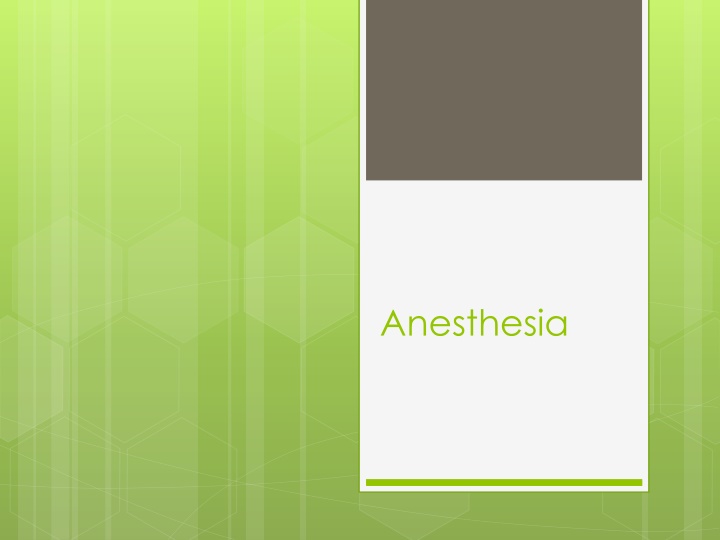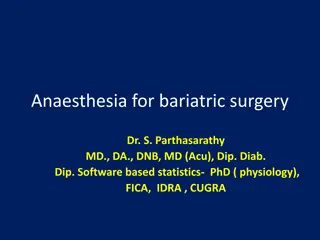Anesthesia: Types and Uses in Medical Procedures
Anesthesia, derived from the Greek term for lack of sensation, comes in three main types: local, regional, and general. Local anesthesia allows patients to remain awake and conscious while numbing specific areas of the body. Meanwhile, regional anesthesia, such as epidurals and spinal blocks, can numb wider regions or induce paralysis as needed. Understanding these distinctions is crucial in medical settings.
Download Presentation

Please find below an Image/Link to download the presentation.
The content on the website is provided AS IS for your information and personal use only. It may not be sold, licensed, or shared on other websites without obtaining consent from the author.If you encounter any issues during the download, it is possible that the publisher has removed the file from their server.
You are allowed to download the files provided on this website for personal or commercial use, subject to the condition that they are used lawfully. All files are the property of their respective owners.
The content on the website is provided AS IS for your information and personal use only. It may not be sold, licensed, or shared on other websites without obtaining consent from the author.
E N D
Presentation Transcript
Intro http://youtu.be/Ig-pZ4OyidY
Meaning Derived from the Greek term for loss or lack of sensation 3 Types of Anesthesia Local Regional General
Local Anesthesia Remain awake and conscious Insensitivity to pain, but can still feel pressure and sensation Given in the form of spray, shot or ointment Only numbs small, specific areas of the body
Local Anesthetic Often used in dental offices when numbing an area of the oral cavity Can be topical (on the surface) Topical often applied before needle injection of local anesthetic
Local Anesthesia Drugs used include lidocaine, Novocaine, and tetracaine Originally, cocaine was used Had to find alternatives because of its addictive qualities
Local Anesthesia Used in minor outpatient surgeries Effects wear off in 4 to 5 hours Need to be cautious around numb area afterwards to prevent harm For example, biting a numb cheek
Regional Anesthesia Numbs a wider region of the body than local Peripheral regional anesthesia blocks a nerve or nerve bundle to numb a limb Central anesthesia injects anesthetic into cerebrospinal fluid or into space outside spinal canal
Regional Anesthesia Epidurals Central anesthetic given to women in labor Drugs are continuously fed into epidural space via catheter Loss of sensation from waist down
Regional Anesthesia Spinal block Drugs injected into cerebrospinal fluid One time injection; no catheter needed Waist-down paralysis (more than epidurals)
Regional Anesthesia More risky than local Possible seizure or heart attack because of involvement with Central Nervous System If more paralysis is needed, may switch to general anesthesia Strict monitoring of patients under regional anesthesia
General Anesthesia Completely unconscious and immobilized Administered via IV (needle into vein) or gas (mask or tube) or a combination of both
General Anesthesia Used in major surgeries that require long lengths of time For example, knee replacement or heart bypass
General Anesthesia Use a combination of medications to Relieve anxiety Keep you asleep Minimize pain Relax muscles to prevent movement Block out memory of surgery
General Anesthesia General anesthesia affects The spinal cord, causing immobility Brain stem, causing unconsciousness Cerebral cortex, causing changes in brain s electrical activity
General Anesthesia An anesthesiologist is present before, during, and after operation Medical history is reviewed before hand Anesthesia requires certain conditions for patients with low blood pressure or those that are alcohol/drug users
General Anesthesia Monitors during operation Pulse oximetry (oxygen levels in blood), heart rate, blood pressure, respiratory rates, carbon dioxide exhalation levels, temperature, concentration of anesthetic, brain activity
General Anesthesia Stages 1. Induction: starting to feel the effects, but not yet unconscious 2. Excitement: unconscious, short period of irregular breathing and heart rate 3. Anesthetized: muscle relaxation, regular breathing 4. Overdose: does not regularly occur, but swift action should be taken to prevent heart/breathing stoppage, brain damage, or death
General Anesthesia Side effects afterwards Vomiting Nausea Numbness in area operated on Disorientation
General Anesthesia Serious risks Suffocation Allergic reaction Organ failure Stroke Death
Which Type to Use? Depends on: Type of Surgery Location of Surgery Length of Surgery Current and previous medical conditions Allergies Reaction to anesthesia Medications currently taking Age, height, weight
References http://science.howstuffworks.com/anesth esia.htm http://kidshealth.org/teen/your_body/me dical_care/anesthesia_types.html#























